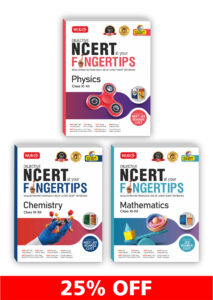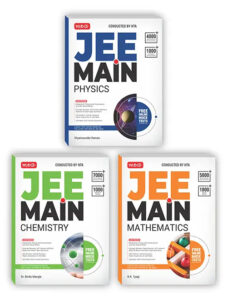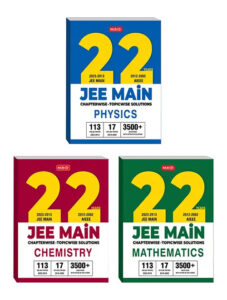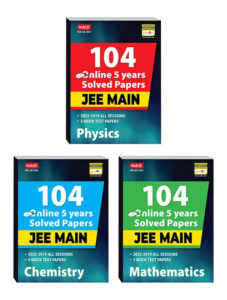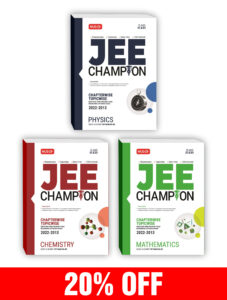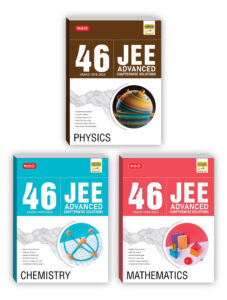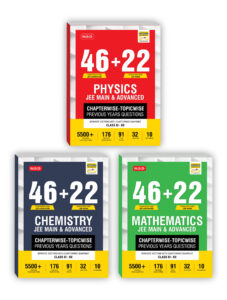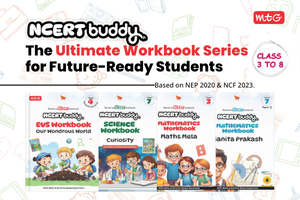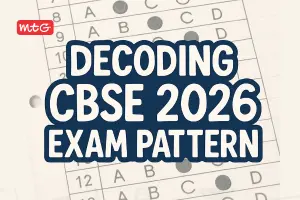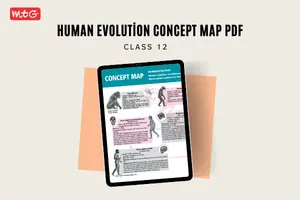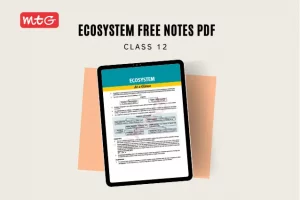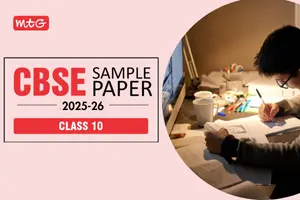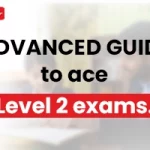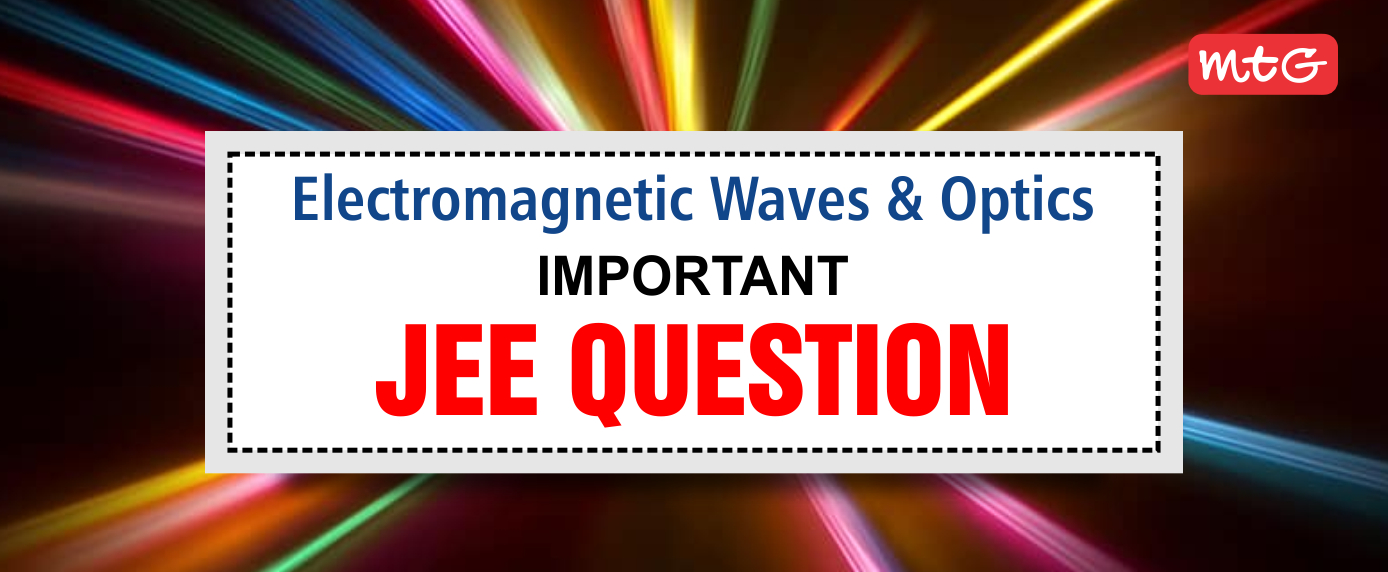
Many important questions are formed in competitive exams like CUET, JEE, NEET, and boards from Class 12 Physics. Below, we have provided Important Questions from Class 12 Physics Unit 5 and 6, Electromagnetic Waves and optics for your JEE Mains 2023 preparation. You can check it here for revision purposes.
Latest: Electromagnetic Induction and Alternating Currents JEE Questions and Answers
Electromagnetic Waves Class 12 & Optics JEE Mains Questions and Answers
We’ve compiled a list of important questions about the Electromagnetic Waves Class 12 & Optics physics class 12 unit 5 and 6 that you should not miss while studying for your JEE Main Exams.
Q.1. In a single slit diffraction pattern, the distance between the first minimum on the left and the first minimum on the right is 5 mm. The screen on which the diffraction pattern is displayed is at a distance of 80 cm from the slit. The wavelength is 6000 Å. The slit width (in mm) is about
(a) 0.576 (b) 0.348
(c) 0.192 (d) 0.096
A.1. (c)
Explanation:
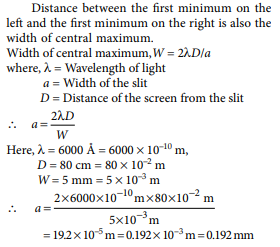
Q.2. A slab of a material of refractive index 2.0 shown in figure, has a curved surface APB of radius of curvature 10 cm and a plane surface CD. On the left of APB is air and on the right of CD is water with refractive indices as given in the figure. An object O is placed at a distance of 15 cm from the pole P as shown. The distance of the final image of O from P, as viewed from the left is
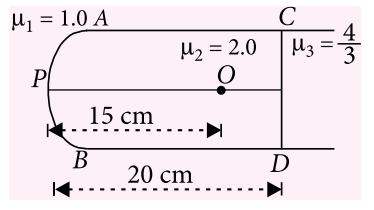
(a) 10 cm (b) 20 cm
(c) –30 cm (d) –20 cm
A.2. (c)
Explanation:
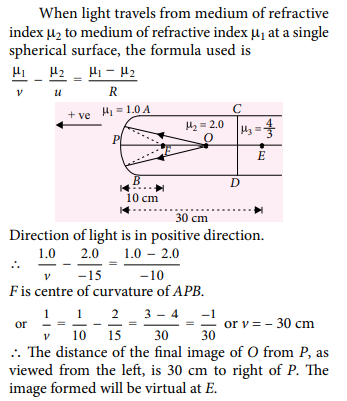
Q.3. When a light of wavelength 4000 Å in vacuum travels through the same thickness in diamond and water separately, the difference in the number of waves is 200. Find the thickness, if refractive indices of diamond and water are 5/2 and 4/3 respectively.
(a) 0.685 mm (b) 0.0685 mm
(c) 68.5 mm (d) 6.85 mm
A.3. (b)
Explanation:
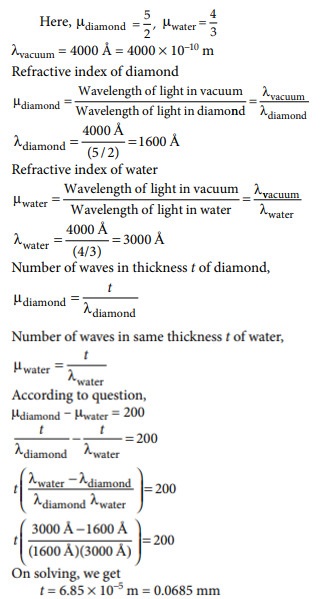
Q.4. A beam of natural light falls on a system of 5 polaroids, which are arranged in succession such that the pass axis of each polaroid is turned through 60° with respect to the preceding one. The fraction of the incident light intensity that passes through the system is
(a) 1/64 (b) 1/32 (c) 1/256 (d) 1/512
A.4. (d)
Explanation:
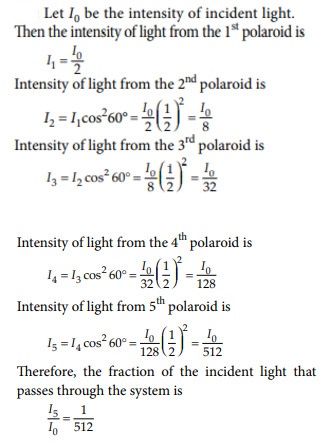
Q.5. A parallel plate capacitor with plate area A and separation between the plates d, is charged by a constant current I. Consider a plane surface of area A/2 parallel to the plates and drawn between the plates. The displacement current through the area is
(a) I (b) I/2 (c) I/4 (d) I/8
A.5. (b)
Explanation:
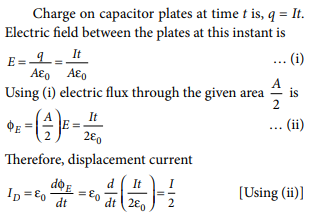
Q.6. A capacitor made of two circular plates each of radius 12 cm and separated by 5 mm. The capacitor is being charged by an external source. The charging current is constant and equal to 0.15 A. The capacitance and displacement current of the parallel plate capacitor are

(a) 40 pF, 20 A (b) 45 pF, 7.5 A
(c) 70 pF, 35 A (d) 80 pF, 0.075 A
A.6. (d)
Explanation:
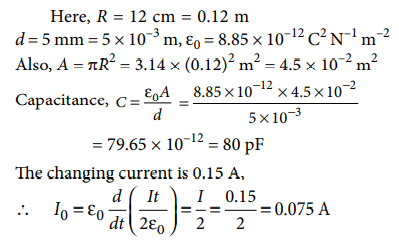
Q.7. Two stars are 10 light years away from the earth. They are seen through a telescope of objective diameter 30 cm. The wavelength of light is 600 nm. To see the stars just resolved by the telescope, the minimum distance between them should be (1 light year = 9.46 × 1015 m) of the order of
(a) 108 km (b) 1010 km
(c) 1011 km (d) 106 km
A.7. (a)
Explanation:
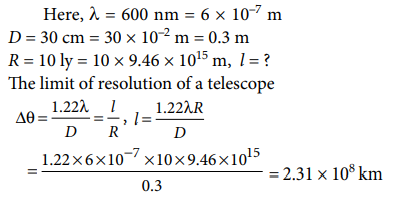
Q.8. Electromagnetic wave consists of periodically oscillating electric and magnetic vectors
(a) in mutually perpendicular planes but vibrating with a phase difference of π
(b) in mutually perpendicular planes but vibrating with a phase difference of π/2
(c) in randomly oriented planes but vibrating in phase
(d) in mutually perpendicular planes but vibrating in phase
A.8. (d)
Explanation:
Electromagnetic wave consists of periodically oscillating electric and magnetic vectors in mutually perpendicular planes but vibrating in phase.
Q.9. An object was placed upright 25 cm in front of a converging lens with a focal length of 20 cm. A concave mirror with a focal length of 15 cm was placed 120 cm behind the lens. Which of these describes the final image?
(a) real, enlarged (b) virtual, upright
(c) virtual, inverted (d) inverted, diminished
A.9. (a)
Explanation:
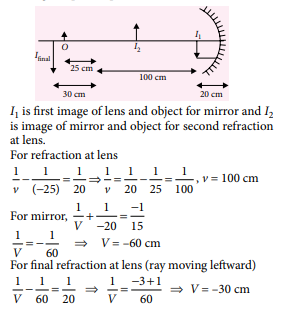
Final magnification = (–4) × (–3) × (–1/2) = –6
Final image is real, inverted and enlarged.
Q.10. A hemispherical glass body of radius 10 cm and refractive index 1.5 is silvered on its curved surface. A small air bubble is 6 cm below the flat surface inside it along the axis. The position of the image of the air bubble made by the mirror is seen
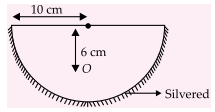
(a) 14 cm below flat surface
(b) 20 cm below flat surface
(c) 16 cm below flat surface
(d) 30 cm below flat surface
A.10. (b)
Explanation:
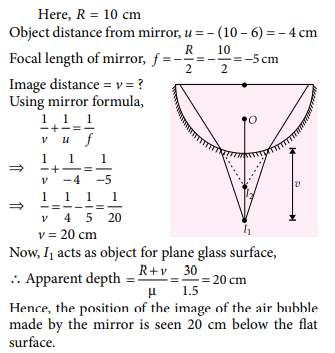
Q.11. The figure shows the initial position of a point source of light S, a detector D and a lens L. Now at t = 0, all the three start moving towards right with different velocities as shown. The time(s) at which the detector receives the maximum light is
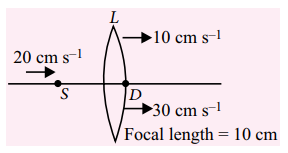
(a) 0.56 s and 8.94 s (b) 3.8 s
(c) 8.94 s and 19.62 s (d) 0.56 s
A.11. (a)
Explanation:
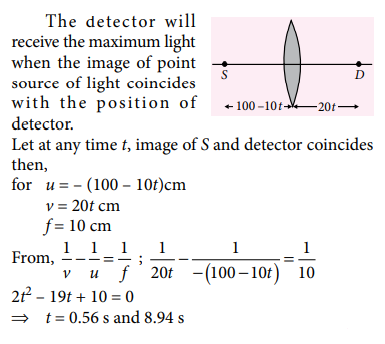
Q.12. When the frequency of the light used is changed from 4 × 1014 s –1 to 5 × 1014 s–1, the angular width of the principal (central) maximum in a single slit Fraunhoffer diffraction pattern changes by 0.6 radian. What is the width of the slit (assume that the experiment is performed in vacuum)?
(a) 1.5 × 10–7 m (b) 3 × 10–7 m
(c) 5 × 10–7 m (d) 6 × 10–7 m
A.12. (c)
Explanation:
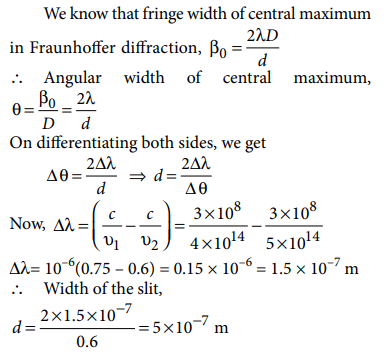
Best JEE Books Recommended by JEE Toppers
Check out some of the best JEE Books recommended by JEE Toppers
- NCERT Textbook
One thing that is strongly recommended is that students prepare using NCERT textbooks. Toppers endorse NCERT as the finest book for JEE Main. NCERT is the foundation for these exams since they cover everything and consist of enormous information. Each and every line of NCERT must be clear and embedded in your mind to know the concepts better.
|
22 Years JEE Main Imagine having 21 years’ worth of experience for JEE Main? That is what you’ll get with this series of Physics, chemistry, and mathematics books. MTG’s 22 Years JEE Main Chapter-wise Topic-wise Solutions Physics is the best question bank having questions from the past 22 years of JEE Main Physics (2022-2013) & AIEEE (2012-2002) which are segregated Chapter-wise Topic-wise. |
|
JEE Champion JEE Champion is a book designed for JEE aspirants to prepare better with the knowledge of topic importance within a chapter. It familiarizes all the JEE aspirants with a wide variety of questions frequently asked in various engineering entrance exams. It covers 10 years of questions for all the major engineering exams. Students can understand the changing pattern of questions asked and can gain mastery over questions asked during exams.
|
|
46+22 Years Chapterwise Topicwise Solutions • 46 Previous Years’ Papers of JEE Advanced/IIT JEE |

